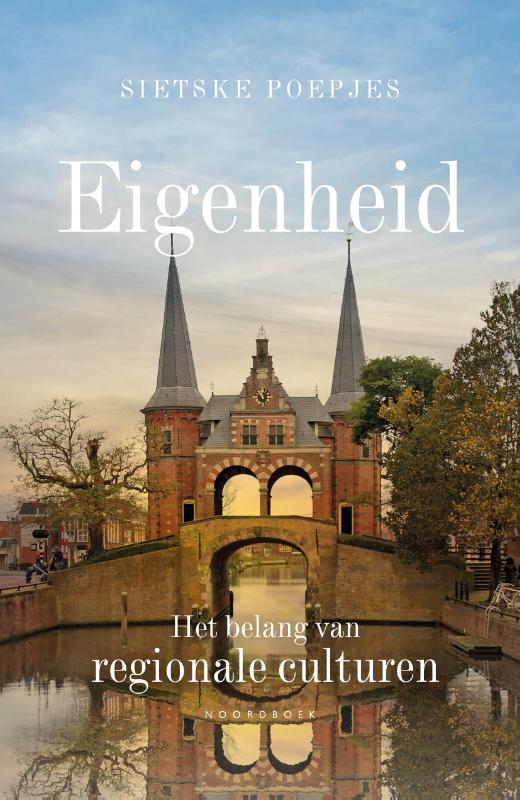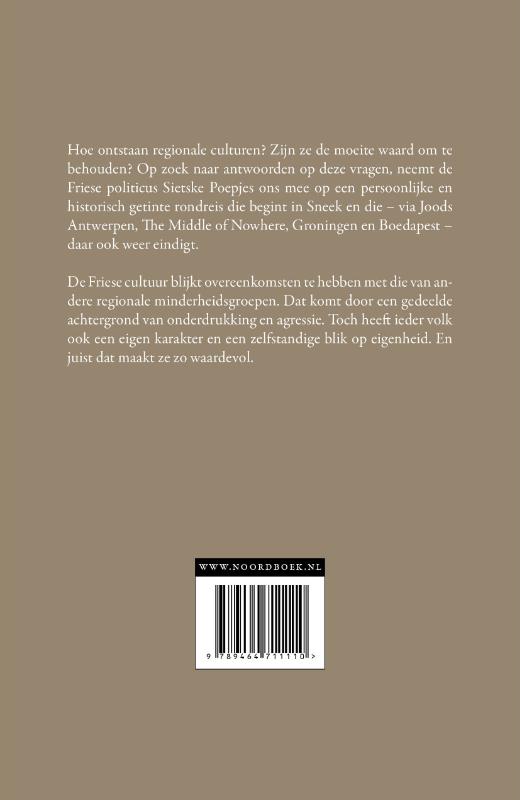Eigenheid
€ 24,90
Hoe ontstaan regionale culturen? Zijn ze de moeite waard om te behouden? Op zoek naar antwoorden op deze vragen, neemt de Friese politicus Sietske Poepjes ons mee op een persoonlijke en historisch getinte rondreis die begint in Sneek en die – via Joods Antwerpen, The Middle of Nowhere, Groningen en Boedapest – daar ook weer eindigt.
De Friese cultuur blijkt overeenkomsten te hebben met die van andere regionale minderheidsgroepen. Dat komt door een gedeelde achtergrond van onderdrukking en agressie. Toch heeft ieder volk ook een eigen karakter en een zelfstandige blik op eigenheid. En juist dat maakt ze zo waardevol.
Sietske Poepjes (Harlingen, 1979) is een jurist en CDA-politicus. Ze studeerde Staats- en Bestuursrecht en Rechtstheorie aan de Rijksuniversiteit Groningen en werkte daarna als beleidsmedewerker ruimtelijke ordening en als juridisch controller bij de gemeente Lemsterland. Daarna was zij juridisch adviseur bij de Stichting Duurzame Garnalenvisserij en lid van de Provinciale Staten van Fryslân. Sinds 2011 is zij lid van de Gedeputeerde Staten van Fyslân. Ze bekleedde diverse portefeuilles en heeft sinds 2019 de portefeuilles Klimaat, Energie, Cultuur, Onderwijs en taal. Daarnaast was zij tot de zomer van 2023 loco-commissaris van de Koning.
Gerelateerde boeken
-
Voorjaarstradities in Drenthe
€ 29,95Het zonlicht glijdt over een kaal landschap. De dagen worden langzaam langer, de zon warmer en de natuur weer groen: de winter maakt plaats voor de lente. Een periode die sinds oudsher wordt geassocieerd met vruchtbaarheid, wedergeboorte en een nieuw begin. Een periode die rijk is aan gebruiken en tradities om dit te vieren.
Drenthe heeft een groot aantal tradities voor het toejuichen en verwelkomen van de lente. Sommige daarvan kennen we nu nog, zoals het Paasvuur, anderen zijn in vergetelheid geraakt; wie weet tegenwoordig bijvoorbeeld nog wat een Pinksterbroed is of kan nog een hupholt fluitje maken?
In Voorjaarstradities in Drenthe maak je kennis met oude en nieuwe gebruiken in de periode van Sint-Pieter (22 februari) tot en met Pinksteren. Het boek geeft een gevarieerd beeld van hoe men vroeger en nu het voorjaar beleeft, op een informatieve en toegankelijke manier, rijk aangevuld met beeldmateriaal. Het laat zien hoe tradities zijn veranderd, verdwenen en nieuwe zijn ontstaan.
Ook is er ruim aandacht voor de Drentse taal. Er wordt ingezoomd op Drentse woorden die specifiek zijn voor deze periode en de informatieve onderwerpen worden afgewisseld met Drentstalige gedichten en verhalen. Ook geschikt voor lezers die de Drentse taal niet bijzonder machtig zijn.
-
Van Neanderthaler tot Rendierjager
€ 17,50‘Van neanderthaler tot rendierjager’ is het eerste deel in een toegankelijk en rijk geïllustreerde reeks over de archeologie van Drenthe. Meer dan 115.000 jaar geleden liet een neanderthaler zijn vuurstenen werktuig achter in wat wij nu Drenthe noemen. Voor zover we weten was hij of zij de allereerste mens in deze contreien. In de daaropvolgende 85.000 jaar zou deze nu uitgestorven menssoort met tussenpozen in Drenthe verblijven. Van hun aanwezigheid zijn echter niet veel sporen achtergebleven. Alleen hun stenen werktuigen herinneren ons aan deze lang vervlogen tijden. Archeologen kunnen echter veel afleiden aan deze oeroude artefacten. Waar zijn ze voor gebruikt? Hoe zijn ze gemaakt en wat vertellen ze ons over het leven van de neanderthaler in Drenthe?
Zo’n 40.000 jaar geleden stierf de neanderthaler uit en bleef de nieuwkomer Homo sapiens alleen achter. Omdat het noorden van Europa gevangen was in de ijskoude greep van de ijstijd leefden onze verre voorouders in eerste instantie alleen in meer zuidelijkere regio’s. Maar toen de temperatuur steeg, trokken ook deze jagers op den duur naar Drenthe. Omdat zij voornamelijk leefden van de jacht op rendieren, noemen wij hen ‘rendierjagers’. In een tijd van zeer snelle klimaatwisselingen aan het einde van de laatste ijstijd volgden verschillende rendierjagersculturen elkaar snel op. Ook van deze mensen zijn de meeste sporen volledig verdwenen, maar dankzij resten van hun kampementen, haardplaatsen en wederom stenen werktuigen vangen we een glimp op van hun dagelijks leven.
In ’Van neanderthaler tot rendierjager’ vertellen wij het verhaal van deze prehistorische mensen die leefden in wat archeologen de Oude Steentijd noemen. In een voor ons onherkenbaar Drenthe, volkomen afhankelijk van het klimaat en van wat de natuur hen bood, hadden zij allen hun eigen manier om hier een bestaan op te bouwen. Maar of dit altijd even succesvol was….
De reeks ‘Archeologie in Drenthe’ is een samenwerking van Stichting Het Drentse Landschap, Het Hunebedcentrum, Stichting Stone en Uitgeverij Koninklijke Van Gorcum.
-





